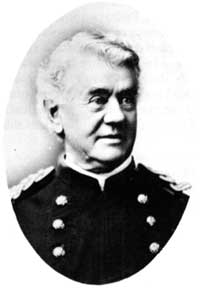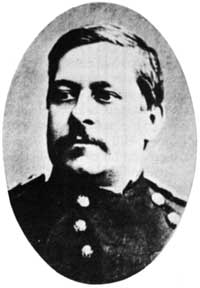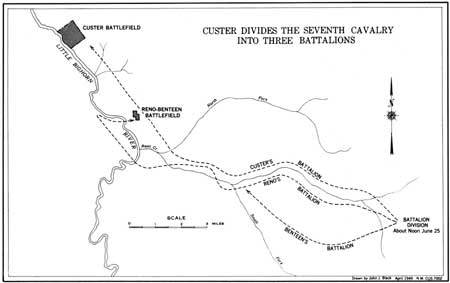|
LITTLE BIGHORN BATTLEFIELD National Monument |
 |
 Capt. Frederick W. Benteen, Seventh United States Cavalry. (Photograph by D. F. Barry.) |
 Maj. Marcus A. Reno, Seventh United States Cavalry. (Photograph by D. F. Barry.) |
Custer Divides His Command, and Reno Engages the Indians
About noon on June 25, Custer divided his command into three battalions. These were divided as follows: Three companies (A, G, and M) under the command of Maj. Marcus A. Reno, three (H, D, and K) under Capt. Frederick W Benteen, and five (C, E, F, I, and L) under his (Custer's) immediate command, with the last company (B) protecting the pack train which was to follow the column as closely as possible. Benteen was sent immediately to make a scout to the left of the trail while Custer and Reno followed on opposite banks of a small creek toward the Little Bighorn Valley.
About 2 miles from the Little Bighorn River, portions of the Indian encampment were viewed lying on the west bank of the river and extending farther downstream. Reno was told to move on down, cross the river, and charge this camp. Custer turned to the right, evidently planning to support Reno's attack in the river bottom by suddenly appearing in the lower end of the Indian camp and attacking their flank and rear.
At about 2:30 p. m., Major Reno crossed the Little Bighorn River to its west side and advanced down the valley toward the Indian camps. He had not gone far when it became evident that there were a great many more tepees and Indians in the valley than had been observed from the hills prior to his separation from Custer. Bluffs and the foliage of tall cottonwood trees had hidden the camps from their view.
The Indian warriors swarmed into the open view as Reno and his men rode down the valley. Shortly after the battle between Reno's troops and the Indians began, Reno had his men dismount and deploy in a skirmish line to fight on foot. This move tended to check the onrush of the Indians. After almost half an hour, the increasing number of Indians forced the soldiers into a timber thicket. A defensive stand was made here until Reno ordered his men to mount and retreat to the bluffs.
The retreat of the soldiers became a panicky flight, with every man for himself, while the Indians continued their attack until the troops crossed the river. About a third of the whites dropped out, either having been killed, wounded, or forced to seek cover in the brush. The others crossed the river and reached the top of the hill on the east side. Here they took a defensive position. Few Indians followed them beyond the river.

Custer divides the Seventh Cavalry into three battalions.
(click on image for an enlargement in a new window)

|
|
Last Modified: Sat, Sep 28 2002 10:00:00 pm PDT |


